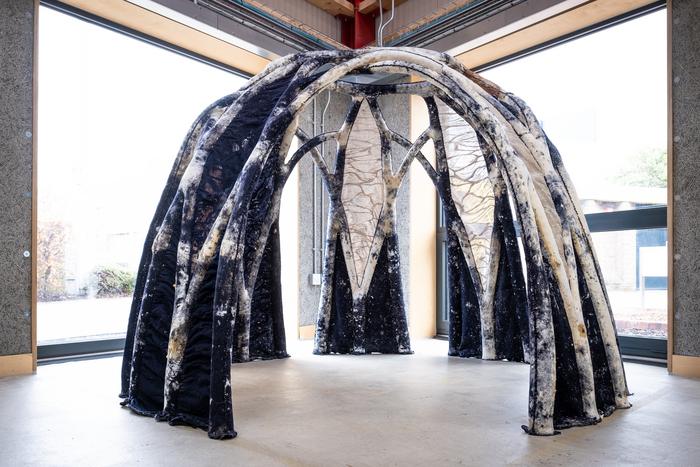Bio-Knit: How Fungi and Textiles Are Weaving the Future of Construction
The fusion of biology and architecture takes a significant step forward as scientists successfully grow building materials using fungi and knitted molds
Jul 18, 2023
Courtesy of the Hub for Biotechnology in the Built Environment
In a groundbreaking fusion of architecture and biology, a team of multidisciplinary experts has cultivated a pioneering technique to fashion eco-friendly construction materials from fungi, breathing fresh life into the industry and signaling a potential departure from conventional practices. This innovative process employs the subterranean web-like structures of fungi, known as mycelium, nurtured within the unconventional setting of knitted molds, enabling more diverse shapes and utility in construction materials—a limitation that had previously stifled their broader application.
The resultant composite, dubbed "mycocrete", takes us one step closer to revolutionizing the construction industry, transitioning to a more sustainable and environmentally conscious future. Harnessing the versatility of knitted molds and the power of mycelium, scientists have been able to create a substance stronger and more adaptable in form than ever before.
"Our ambition is to transform the look, feel, and well-being of architectural spaces using mycelium in combination with biobased materials such as wool, sawdust, and cellulose," said Dr. Jane Scott of Newcastle University, who played a leading role in the research, conducted by the Living Textiles Research Group. Findings from the study were published recently in Frontiers in Bioengineering and Biotechnology.

“This paper presents significant advances in mycelium biofabrication using permanent knitted textile formwork and a new substrate formulation to dramatically improve the mechanical properties of mycelium-textile biocomposites suitable for large-scale components for use in construction,” the authors wrote. “The paper outlines the biofabrication process, detailing the composition of mycocrete, a viscous mycelium substrate developed for use with permanent knitted formwork, and the injection process required to regulate the filling of slender tubes of fabric with mycocrete. The use of a permanent integrated knitted formwork shows promise as a composite system for use with mycelium to improve mechanical performance and enable complex shapes to be fabricated for lightweight construction.”
The synthesis of mycocrete entails an intriguing dance between natural and synthetic elements. Mycelium spores are mixed with sustenance-rich grains and a growth medium, which is then encased within a mold. The mold is then left to foster in a dark, humid, and warm environment. As the mycelium flourishes, it binds the mixture together. The drying process of this densely woven material could provide an eco-friendly alternative to foam, timber, and plastic. However, this process has historically been hindered by the need for oxygen, restricting the size and shape of the molds used.
With their novel approach, Scott and her team surmounted this limitation through the introduction of knitted textiles, an oxygen-permeable alternative to conventional molds, which adapt from flexible to rigid with the growth of the mycelium. “Knitting is an incredibly versatile 3D manufacturing system,” said Scott. “It is lightweight, flexible, and formable. The major advantage of knitting technology compared to other textile processes is the ability to knit 3D structures and forms with no seams and no waste.”
The scientists developed a specialized mixture and an advanced production system to maximize the potential of these knitted molds. Alongside traditional mycelium composite samples, they produced mycocrete samples, a mix of mycelium, paper powder, paper fiber clumps, water, glycerin, and xanthan gum. This mix was carefully infused into the knitted molds with an injection gun, ensuring consistency while maintaining its form.
Following a meticulous drying process, the strength of the mycocrete samples was tested under tension, compression, and flexion. Proving to be a stronger and more robust construction material, the mycocrete outperformed conventional mycelium composites, with the knitted fabric mold offering superior oxygen availability and reduced shrinkage during drying.
Further validating their innovative creation, the team built a complex proof-of-concept dome structure called BioKnit, constructed from a single piece of knitted form, underscoring the potential this has in reimagining architectural possibilities.
"The mechanical performance of the mycocrete used in combination with permanent knitted formwork is a significant result and a step towards the use of mycelium and textile biohybrids within construction," said Scott. "In this paper, we have specified particular yarns, substrates, and mycelium necessary to achieve a specific goal. However, there is extensive opportunity to adapt this formulation for different applications. Biofabricated architecture may require new machine technology to move textiles into the construction sector."


















